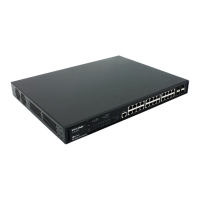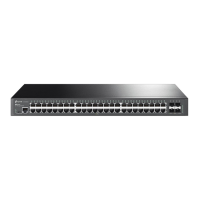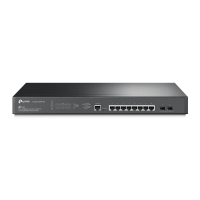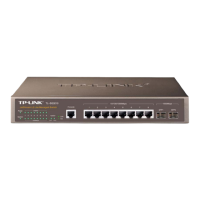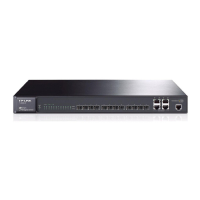Do you have a question about the TP-Link JetStream TL-SG3424 and is the answer not in the manual?
Identifies the target audience for the user guide, focusing on network professionals.
Explains the formatting and symbols used throughout the guide for clarity.
Provides a brief summary of the guide's structure and the content of each chapter.
Introduces the TL-SG3424 switch, its features, performance, and target use cases.
Details the key features of the switch, including resiliency, layer 2 switching, QoS, security, and manageability.
Details the components and LEDs on the switch's front panel for identification.
Describes the rear panel of the switch, including power socket and grounding terminal.
Guides users on how to access the switch's configuration utility via IPv4 and IPv6 networks.
Explains how to navigate and utilize the switch's main setup menu after a successful login.
Covers viewing and configuring system details like port status, device description, time, and IP addresses.
Details how to manage user accounts, access levels, and passwords for switch configuration.
Explains essential system management tools like configuration backup, restore, reboot, and reset.
Outlines security measures for remote login, including access control, SSL, and SSH configurations.
Configures basic port parameters such as speed, duplex, status, security, and isolation.
Explains Link Aggregation Group (LAG) for combining ports to increase bandwidth and reliability.
Monitors port traffic statistics, including summary and detailed traffic data.
Manages MAC address entries, including static, dynamic, and filtering configurations.
Details the configuration of 802.1Q VLANs, including port types and packet processing.
Explains how to classify VLANs based on MAC addresses for specific host access control.
Describes classifying VLANs based on network protocols for specific service delivery.
Provides a practical example demonstrating the configuration of 802.1Q VLANs in a network.
Illustrates the configuration of MAC VLANs with specific network requirements and topology.
Shows a scenario for configuring Protocol VLANs to manage traffic based on network protocols.
Explains GARP VLAN Registration Protocol (GVRP) for dynamic VLAN information exchange.
Covers global configuration of Spanning Tree Protocol (STP), including parameters and versions.
Configures Spanning Tree parameters for individual ports, including status, priority, and role.
Details Multiple Spanning Tree Protocol (MSTP) instance configuration, region, and VLAN mapping.
Implements security features to protect against STP attacks, like BPDU guard and root protect.
Manages multicast group membership by listening to IGMP messages for efficient data distribution.
Handles IPv6 multicast data distribution by selectively forwarding packets based on MLD snooping.
Displays and manages IPv4/IPv6 multicast group information and forwarding tables.
Configures traffic classification and priority mapping based on port, 802.1P, or DSCP.
Manages traffic rates per port using rate limiting and storm control to optimize bandwidth.
Configures Voice VLANs to prioritize voice traffic and ensure quality, using OUI addresses for identification.
Defines time ranges (absolute, weekly, holiday) for ACL rule effectiveness, enabling time-based policies.
Covers the creation and management of Access Control Lists (ACLs), including MAC and IP ACLs.
Creates and manages policies that define actions for packets matching ACL rules, like mirroring or QoS.
Binds policies to specific ports or VLANs to enforce access control rules effectively.
Demonstrates practical ACL configuration scenarios for controlling network access and traffic.
Binds IP addresses to MAC addresses for enhanced network access control and ARP security.
Detects and mitigates ARP attacks like spoofing and man-in-the-middle attacks.
Protects against Denial of Service (DoS) attacks by identifying and blocking malicious traffic.
Implements port-based network access control using IEEE 802.1X for user authentication.
Configures SNMP globally, views, groups, users, and communities for network management.
Configures SNMP traps and informs to alert the management station about important network events.
Enables Remote Monitoring (RMON) for detailed network traffic statistics, events, and alarms.
Collects neighbor information using Neighbor Discovery Protocol (NDP) to support cluster establishment.
Discovers network topology by collecting NTDP information for commander switch management.
Manages cluster status, roles, and configurations for centralized control of network devices.
Demonstrates a practical setup for managing multiple switches within a cluster via a commander switch.
Monitors switch CPU and memory utilization to detect performance issues or potential attacks.
Manages system logs, including viewing tables, local/remote logging, and backup.
Provides tools for diagnosing device issues, such as cable testing and loopback tests.
Performs network diagnostics like Ping and Tracert to identify connectivity and reachability issues.
Identifies the target audience for the user guide, focusing on network professionals.
Explains the formatting and symbols used throughout the guide for clarity.
Provides a brief summary of the guide's structure and the content of each chapter.
Introduces the TL-SG3424 switch, its features, performance, and target use cases.
Details the key features of the switch, including resiliency, layer 2 switching, QoS, security, and manageability.
Details the components and LEDs on the switch's front panel for identification.
Describes the rear panel of the switch, including power socket and grounding terminal.
Guides users on how to access the switch's configuration utility via IPv4 and IPv6 networks.
Explains how to navigate and utilize the switch's main setup menu after a successful login.
Covers viewing and configuring system details like port status, device description, time, and IP addresses.
Details how to manage user accounts, access levels, and passwords for switch configuration.
Explains essential system management tools like configuration backup, restore, reboot, and reset.
Outlines security measures for remote login, including access control, SSL, and SSH configurations.
Configures basic port parameters such as speed, duplex, status, security, and isolation.
Explains Link Aggregation Group (LAG) for combining ports to increase bandwidth and reliability.
Monitors port traffic statistics, including summary and detailed traffic data.
Manages MAC address entries, including static, dynamic, and filtering configurations.
Details the configuration of 802.1Q VLANs, including port types and packet processing.
Explains how to classify VLANs based on MAC addresses for specific host access control.
Describes classifying VLANs based on network protocols for specific service delivery.
Provides a practical example demonstrating the configuration of 802.1Q VLANs in a network.
Illustrates the configuration of MAC VLANs with specific network requirements and topology.
Shows a scenario for configuring Protocol VLANs to manage traffic based on network protocols.
Explains GARP VLAN Registration Protocol (GVRP) for dynamic VLAN information exchange.
Covers global configuration of Spanning Tree Protocol (STP), including parameters and versions.
Configures Spanning Tree parameters for individual ports, including status, priority, and role.
Details Multiple Spanning Tree Protocol (MSTP) instance configuration, region, and VLAN mapping.
Implements security features to protect against STP attacks, like BPDU guard and root protect.
Manages multicast group membership by listening to IGMP messages for efficient data distribution.
Handles IPv6 multicast data distribution by selectively forwarding packets based on MLD snooping.
Displays and manages IPv4/IPv6 multicast group information and forwarding tables.
Configures traffic classification and priority mapping based on port, 802.1P, or DSCP.
Manages traffic rates per port using rate limiting and storm control to optimize bandwidth.
Configures Voice VLANs to prioritize voice traffic and ensure quality, using OUI addresses for identification.
Defines time ranges (absolute, weekly, holiday) for ACL rule effectiveness, enabling time-based policies.
Covers the creation and management of Access Control Lists (ACLs), including MAC and IP ACLs.
Creates and manages policies that define actions for packets matching ACL rules, like mirroring or QoS.
Binds policies to specific ports or VLANs to enforce access control rules effectively.
Demonstrates practical ACL configuration scenarios for controlling network access and traffic.
Binds IP addresses to MAC addresses for enhanced network access control and ARP security.
Detects and mitigates ARP attacks like spoofing and man-in-the-middle attacks.
Protects against Denial of Service (DoS) attacks by identifying and blocking malicious traffic.
Implements port-based network access control using IEEE 802.1X for user authentication.
Configures SNMP globally, views, groups, users, and communities for network management.
Configures SNMP traps and informs to alert the management station about important network events.
Enables Remote Monitoring (RMON) for detailed network traffic statistics, events, and alarms.
Collects neighbor information using Neighbor Discovery Protocol (NDP) to support cluster establishment.
Discovers network topology by collecting NTDP information for commander switch management.
Manages cluster status, roles, and configurations for centralized control of network devices.
Demonstrates a practical setup for managing multiple switches within a cluster via a commander switch.
Monitors switch CPU and memory utilization to detect performance issues or potential attacks.
Manages system logs, including viewing tables, local/remote logging, and backup.
Provides tools for diagnosing device issues, such as cable testing and loopback tests.
Performs network diagnostics like Ping and Tracert to identify connectivity and reachability issues.
| Switching Capacity | 48 Gbps |
|---|---|
| Forwarding Rate | 35.7 Mpps |
| MAC Address Table | 8K |
| Jumbo Frame | 9KB |
| Power Supply | 100-240VAC, 50/60Hz |
| Ports | 24x 10/100/1000Mbps RJ45 ports, 4x 1G SFP slots |
| Standards and Protocols | IEEE 802.3, IEEE 802.3u, IEEE 802.3ab, IEEE 802.3z, IEEE 802.3x, IEEE 802.1Q, IEEE 802.1p, IEEE 802.1D, IEEE 802.1s, IEEE 802.1w |
| Dimensions | 440 × 220 × 44 mm |
| Operating Temperature | 0°C to 40°C (32°F to 104°F) |
| Storage Temperature | -40°C to 70°C (-40°F to 158°F) |
| Operating Humidity | 10% to 90% (non-condensing) |
| Storage Humidity | 5% to 90% (non-condensing) |

